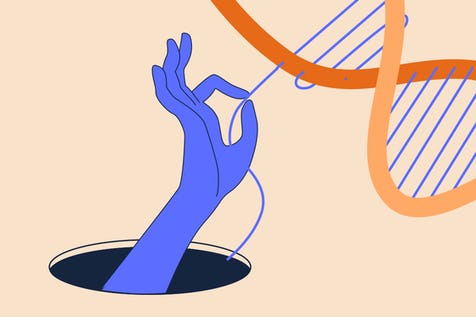If you’ve started to learn more about fertility and the reproductive system, you’ve probably come across the importance of hormones. You might also be familiar with the star players like estrogen and progesterone, but to get the entire picture, we also need to understand lesser-known hormones like GnRH which are orchestrating these processes behind the scenes.
Before we dive into GnRH directly, let’s remind ourselves what hormones are and what their role is. Hormones are our bodies’ chemical messengers that coordinate all kinds of functions in the body. They get released by different glands into the bloodstream and reach their target organs, telling them what they should do and how they should do it.
This applies to all kinds of processes, but they’re especially important to fertility because of their role in the menstrual cycle. This cycle is guided by an intricate dance of hormones that stimulates an egg to be released in the middle of the cycle—also called ovulation—which is necessary for pregnancy to occur.
Now that we have that context, let’s take a deeper look at GnRH’s role in this process.
To put it all in perspective, we have to get a little bit technical, but don’t worry—we’ll break it all down.
What is GnRH?
GnRH is short for gonadotropin-releasing hormone. It’s released by the hypothalamus in the brain, which is connected to the pituitary gland [1]. You can think of these parts of your brain kind of like a command centre—the hypothalamus tells the pituitary gland which hormones to release or inhibit, and those hormones go on to do all kinds of different functions in the body from sleep [2] to menstruation [3].
GnRH is the start of the complex series of hormonal signals that control essential facets of reproduction in both men and women. It starts being produced at a higher level in the body when puberty begins in adolescence. When GnRH is released from the hypothalamus, it triggers the pituitary gland to release two key hormones for reproduction: Follicle-stimulating hormone (FSH) and Luteinizing hormone (LH) [4].
How does GnRH function in both men and women?
In women, the LH and FSH released by the pituitary gland go on to stimulate the development of follicles in the ovaries, which then causes estrogen and progesterone to rise during the menstrual cycle. FSH is responsible for causing the beginning of egg maturation and this rise in estrogen, while LH helps mature the egg and triggers its eventual release during ovulation.
In men, the LH and FSH stimulate the testicles, which then release testosterone and contribute to sperm maturation [4]. GnRH is secreted differently between the sexes, however; in men, it is released through pulses that are consistent in frequency, whereas, in women, the cadence of these pulses varies a lot throughout the different phases of the menstrual cycle [4].
The reproductive hormones like estrogen, progesterone, and testosterone work in a negative feedback loop with GnRH, which helps to keep your body in balance. For example, when the levels of these reproductive hormones are high, the message is sent to the hypothalamus to produce less GnRH. When reproductive hormone levels are low, the opposite will happen and your body will produce more GnRH [4].
Why is GnRH important for fertility?
GnRH is so important to the reproductive system because the other hormones it controls (LH, FSH, and indirectly, estrogen and progesterone) play a huge role in ovulation and conception—in other words, the events that lead you to get pregnant. As such, when there is too much or too little GnRH, it can impact your ability to conceive and is associated with other health conditions.
It’s pretty rare to have too much GnRH. However, having too little is associated with several conditions including:
- Anovulation (cycles where your body does not release an egg) [1]
- Amenorrhea (missed periods) [1]
- Infertility (in both men and women) [5]
- Low sex drive (libido) [5]
This is because a failure to produce GnRH will lead to inadequate production of LH and FSH, which means the ovaries will not release mature eggs and ovulation and menstruation won’t occur. In male infertility, these low levels of LH and FSH lead to low testosterone levels that impede sperm production.
The other reason GnRH is important is that medical treatments have been developed that mimic GnRH’s role in the body and are now used to treat a variety of conditions—including infertility [6].
What are GnRH agonists and antagonists?
Now that we understand what GnRH is and how it functions in the body, we can turn to its medical usage as a treatment for conditions like endometriosis [7], PCOS, [8] and infertility in women [9], as well as conditions like prostate cancer in men [10]. This is where GnRH analogues come in.
GnRH analogues are a class of medications that affect GnRH production in the body, which in turn affects the release of LH and FSH. There are two types of these medications: agonists or antagonists. Agonists stimulate the release of LH and FSH, while antagonists suppress them [11].
For example, when a person is given a GnRH agonist, it mimics real GnRH in the body. [11] When the pituitary gland encounters a GnRH agonist, it will initially release large amounts of LH and FSH, before the body eventually inhibits their release for a period of time, allowing a window for the administration of other hormone therapies [11]
There are two ways that GnRH analogue treatments can be administered: in a pulsatile manner or a continuous one. When GnRH analogues are used in a pulsatile manner, it is generally for a short course of treatment intended to induce ovulation by increasing FSH and LH levels in the body [11]. Continuous treatment, on the other hand, creates a drastic decrease in hormones such as FSH and LH, as well as progesterone, testosterone, and estrogen, which is used to treat hormone-sensitive conditions such as PCOS [11].
Even though they function differently, continuous use of GnRH agonists and antagonists both have the same effect of producing a type of “temporary menopause” in the body that allows for other treatments to be administered. However, GnRH antagonists achieve this by suppressing the release of LH and FSH altogether by preventing the pituitary gland from responding to GnRH, rather than by producing a large surge in these hormones before eventually inhibiting them.
These types of medications are important during processes like IVF treatment because the doctor must be able to control when an egg is released so it may be retrieved and fertilised. The ability to control this through GnRH analogues increases the likelihood of successful IVF treatment [12] GnRH analogue treatments are also helpful in addressing other medical conditions such as fibroids and endometriosis [13].
Recap: GnRH and your fertility
To sum up, GnRH is not only an incredibly important hormone on its own that coordinates many of our body’s reproductive systems, but it’s also a key point for healthcare providers to intervene to help us achieve our goals for conception or to help treat diseases of the reproductive system.
Because of its unique role as the control centre of key hormones like LH and FSH, medicines that mimic it can “shut off” the body’s release of these hormones temporarily which opens up the opportunity to address unwanted symptoms or increase the chances of getting pregnant through IVF.
Understanding the role of these different hormones can seem at first like a complex endeavour, but developing self-knowledge about our bodies can not only help us to conceive but can also help to achieve a more complete picture of our overall health and wellbeing.
The inne minilab helps to achieve this self-knowledge, by offering daily insights into your body’s progesterone levels, giving you the ability to determine where you are in your cycle. The minilab makes tracking your cycle with lab-grade accuracy convenient and accessible so that key knowledge about your body is always at your fingertips.
References
1. Marques P, Skorupskaite K, Rozario KS, et al. Physiology of GnRH and Gonadotropin Secretion. [Updated 2022 Jan 5]. In: Feingold KR, Anawalt B, Boyce A, et al., editors. Endotext [Internet]. South Dartmouth (MA): MDText.com, Inc.; 2000-. Available from: https://www.ncbi.nlm.nih.gov/books/NBK279070/
2. Dorsey, A. et al. (2021). Sleep and Circadian Rhythms. Front. Neurosci., 14 January 2021 https://doi.org/10.3389/fnins.2020.625397
3. Reed BG, Carr BR. (2000). The Normal Menstrual Cycle and the Control of Ovulation. [Updated 2018 Aug 5]. In: Feingold KR, Anawalt B, Boyce A, et al., editors. Available from: https://www.ncbi.nlm.nih.gov/books/NBK279054/
4. Sepideh K., Pegah V. (2018). Gonadotropin Releasing Hormone. Reference Module in Biomedical Sciences. Elsevier. 2018. https://doi.org/10.1016/B978-0-12-801238-3.98031-0.
5. Cleveland Clinic. (2022). Gonadotropin-Releasing Hormone (GnRH). Available from: https://my.clevelandclinic.org/health/body/22525-gonadotropin-releasing-hormone#:~:text=Conditions%20associated%20with%20low%20GnRH%20levels%20in%20males%20include%3A,(no%20sperm%20in%20ejaculate)
6. Magon N. (2011). Gonadotropin releasing hormone agonists: Expanding vistas. Indian journal of endocrinology and metabolism, 15(4), 261–267. https://doi.org/10.4103/2230-8210.85575
7. Küpker, W., Felberbaum, R. E., Krapp, M., Schill, T., Malik, E., & Diedrich, K. (2002). Use of GnRH antagonists in the treatment of endometriosis. Reproductive biomedicine online, 5(1), 12–16. https://doi.org/10.1016/s1472-6483(10)61590-8
8. McCartney CR, Eagleson CA, Marshall JC. Regulation of gonadotropin secretion: implications for polycystic ovary syndrome. Semin Reprod Med. 2002 Nov;20(4):317-26. doi: 10.1055/s-2002-36706. PMID: 12536355.
9. Weiss, J. M., Ludwig, M., Ortmann, O., & Diedrich, K. (2003). GnRH antagonists in the treatment of infertility. Annals of medicine, 35(7), 512–522. https://doi.org/10.1080/07853890310001302
10. Labrie, F. et al. (2005). Gonadotropin-Releasing Hormone Agonists in the Treatment of Prostate Cancer, Endocrine Reviews, Volume 26, Issue 3(1), Pages 361–379, https://doi.org/10.1210/er.2004-0017
11. Ehlers K, Halvorson L (2013). "Gonadotropin-releasing Hormone (GnRH) and the GnRH Receptor (GnRHR)". The Global Library of Women's Medicine. doi:10.3843/GLOWM.10285.
12. Hayden, C. (2008). GnRH analogues: applications in assisted reproductive techniques, European Journal of Endocrinology, 159(suppl_1), S17-S25. Retrieved May 26, 2022, from https://eje.bioscientifica.com/view/journals/eje/159/suppl_1/S17.xml
13. Hodgson R, Bhave Chittawar P, Farquhar C. GnRH agonists for uterine fibroids. Cochrane Database Syst Rev. 2017;2017(10): CD012846. doi:10.1002/14651858.CD012846







